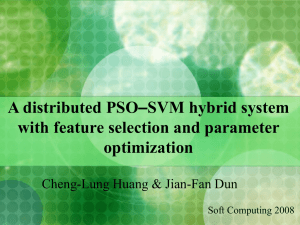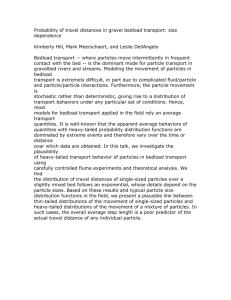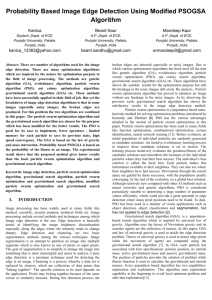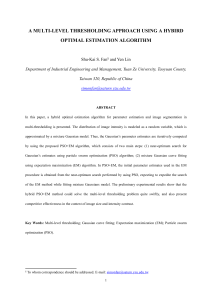Particle Swarm Optimization
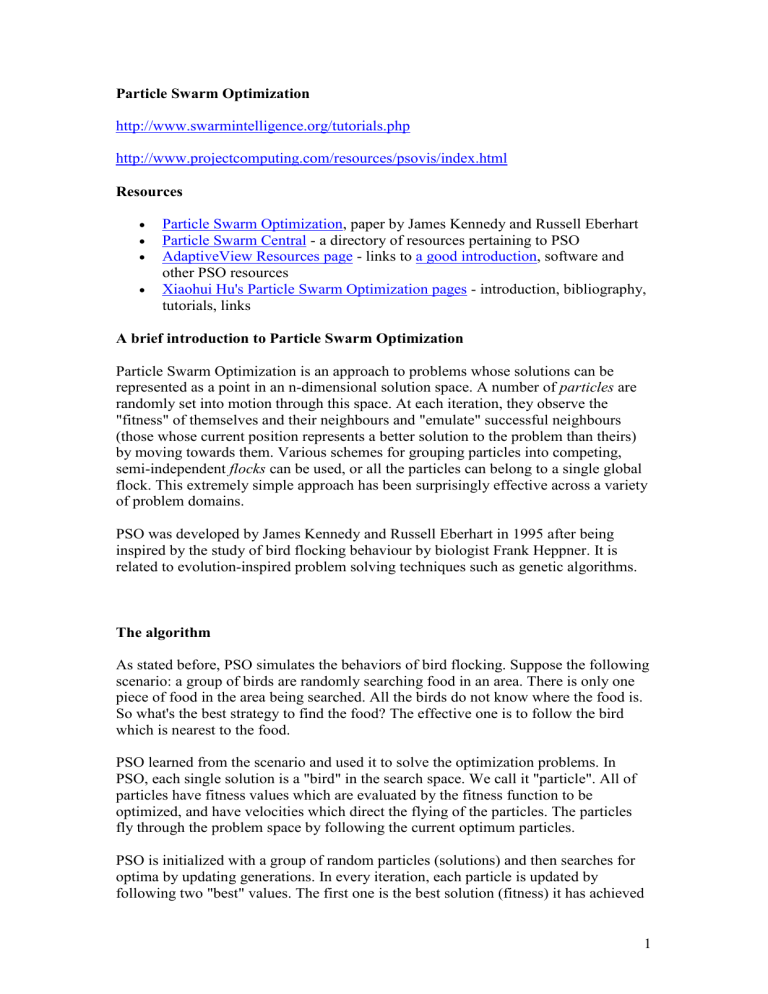
Particle Swarm Optimization http://www.swarmintelligence.org/tutorials.php
http://www.projectcomputing.com/resources/psovis/index.html
Resources
Particle Swarm Optimization , paper by James Kennedy and Russell Eberhart
Particle Swarm Central - a directory of resources pertaining to PSO
AdaptiveView Resources page - links to a good introduction , software and
other PSO resources
Xiaohui Hu's Particle Swarm Optimization pages - introduction, bibliography, tutorials, links
A brief introduction to Particle Swarm Optimization
Particle Swarm Optimization is an approach to problems whose solutions can be represented as a point in an n-dimensional solution space. A number of particles are randomly set into motion through this space. At each iteration, they observe the
"fitness" of themselves and their neighbours and "emulate" successful neighbours
(those whose current position represents a better solution to the problem than theirs) by moving towards them. Various schemes for grouping particles into competing, semi-independent flocks can be used, or all the particles can belong to a single global flock. This extremely simple approach has been surprisingly effective across a variety of problem domains.
PSO was developed by James Kennedy and Russell Eberhart in 1995 after being inspired by the study of bird flocking behaviour by biologist Frank Heppner. It is related to evolution-inspired problem solving techniques such as genetic algorithms.
The algorithm
As stated before, PSO simulates the behaviors of bird flocking. Suppose the following scenario: a group of birds are randomly searching food in an area. There is only one piece of food in the area being searched. All the birds do not know where the food is.
So what's the best strategy to find the food? The effective one is to follow the bird which is nearest to the food.
PSO learned from the scenario and used it to solve the optimization problems. In
PSO, each single solution is a "bird" in the search space. We call it "particle". All of particles have fitness values which are evaluated by the fitness function to be optimized, and have velocities which direct the flying of the particles. The particles fly through the problem space by following the current optimum particles.
PSO is initialized with a group of random particles (solutions) and then searches for optima by updating generations. In every iteration, each particle is updated by following two "best" values. The first one is the best solution (fitness) it has achieved
1
so far. (The fitness value is also stored.) This value is called pbest. Another "best" value that is tracked by the particle swarm optimizer is the best value, obtained so far by any particle in the population. This best value is a global best and called gbest.
When a particle takes part of the population as its topological neighbors, the best value is a local best and is called lbest.
After finding the two best values, the particle updates its velocity and positions with following equation (a) and (b). v[] = v[] + c1 * rand() * (pbest[] - present[]) + c2 * rand() * (gbest[] - present[]) (a) present[] = present[] + v[] (b) v[] is the particle velocity, present[] is the current particle (solution). pbest[] and gbest[] are defined as stated before. rand () is a random number between (0,1). c1, c2 are learning factors. usually c1 = c2 = 2.
The pseudo code of the procedure is as follows
For each particle
Initialize particle
END
Do
For each particle
Calculate fitness value
If the fitness value is better than the best fitness value (pBest) in history
set current value as the new pBest
End
Choose the particle with the best fitness value of all the particles as the gBest
For each particle
Calculate particle velocity according equation (a)
Update particle position according equation (b)
End
While maximum iterations or minimum error criteria is not attained
Particles' velocities on each dimension are clamped to a maximum velocity Vmax. If the sum of accelerations would cause the velocity on that dimension to exceed Vmax, which is a parameter specified by the user. Then the velocity on that dimension is limited to Vmax.
Comparisons between Genetic Algorithm and PSO
Most of evolutionary techniques have the following procedure:
1. Random generation of an initial population
2. Reckoning of a fitness value for each subject. It will directly depend on the distance to the optimum.
3. Reproduction of the population based on fitness values.
4. If requirements are met, then stop. Otherwise go back to 2.
2
From the procedure, we can learn that PSO shares many common points with GA.
Both algorithms start with a group of a randomly generated population, both have fitness values to evaluate the population. Both update the population and search for the optimium with random techniques. Both systems do not guarantee success.
However, PSO does not have genetic operators like crossover and mutation. Particles update themselves with the internal velocity. They also have memory, which is important to the algorithm.
Compared with genetic algorithms (GAs), the information sharing mechanism in PSO is significantly different. In GAs, chromosomes share information with each other. So the whole population moves like a one group towards an optimal area. In PSO, only gBest (or lBest) gives out the information to others. It is a one -way information sharing mechanism. The evolution only looks for the best solution. Compared with
GA, all the particles tend to converge to the best solution quickly even in the local version in most cases.
PSO parameter control
From the above case, we can learn that there are two key steps when applying PSO to optimization problems: the representation of the solution and the fitness function. One of the advantages of PSO is that PSO take real numbers as particles. It is not like GA, which needs to change to binary encoding, or special genetic operators have to be used. For example, we try to find the solution for f(x) = x1^2 + x2^2+x3^2, the particle can be set as (x1, x2, x3), and fitness function is f(x). Then we can use the standard procedure to find the optimum. The searching is a repeat process, and the stop criteria are that the maximum iteration number is reached or the minimum error condition is satisfied.
There are not many parameter need to be tuned in PSO. Here is a list of the parameters and their typical values.
The number of particles: the typical range is 20 - 40. Actually for most of the problems 10 particles is large enough to get good results. For some difficult or special problems, one can try 100 or 200 particles as well.
Dimension of particles: It is determined by the problem to be optimized,
Range of particles: It is also determined by the problem to be optimized, you can specify different ranges for different dimension of particles.
Vmax: it determines the maximum change one particle can take during one iteration.
Usually we set the range of the particle as the Vmax for example, the particle (x1, x2, x3)
X1 belongs [-10, 10], then Vmax = 20
Learning factors: c1 and c2 usually equal to 2. However, other settings were also used in different papers. But usually c1 equals to c2 and ranges from [0, 4]
3
The stop condition: the maximum number of iterations the PSO execute and the minimum error requirement. for example, for ANN training in previous section, we can set the minimum error requirement is one mis-classified pattern. the maximum number of iterations is set to 2000. this stop condition depends on the problem to be optimized.
Global version vs. local version: we introduced two versions of PSO. global and local version. global version is faster but might converge to local optimum for some problems. local version is a little bit slower but not easy to be trapped into local optimim. One can use global version to get quick result and use local version to refine the search.
Another factor is inertia weight, which is introduced by Shi and Eberhart. If you are interested in it, please refer to their paper in 1998. (Title: A modified particle swarm optimizer)
4


